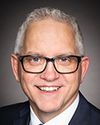Thank you very much, Mr. Chair.
I will try not to use all of the 10 minutes, so that more time may remain for questions.
Thank you for the invitation to appear before the committee.
We meet today on the traditional lands of the Algonquin nation.
With me is Serge Beaudoin, Assistant Deputy Minister of Northern Affairs; Annie Boudreau, Chief Finances, Results and Delivery Officer; and my colleague Martin Reiher, Assistant Deputy Minister at the department.
As the committee begins its important work, we appreciate the opportunity to discuss the role of our department in promoting reconciliation with indigenous peoples.
To begin, I will describe some of my department's work and mention a few recent accomplishments.
Strengthening the relationship with indigenous peoples is central to the mandate of my department. ln pursuit of this goal we've significantly stepped up rights-based discussions with indigenous peoples. Five years ago, most of these discussions only occurred with communities in British Columbia, the Northwest Territories and Atlantic Canada. Today, active discussions are under way with partners from every province and territory—more than 150 processes, more than 500 indigenous communities, and a total of almost 900,000 indigenous people.
lnforming each one of these processes is a fundamental shift in Canada's attitude toward the rights of indigenous peoples. For many years, Canada abided by the concept of extinguishment and sought to have indigenous peoples cede, release and surrender their rights. This is no longer the case. From a legal perspective, Canada no longer interprets section 35 of the Constitution as an empty box, but rather as a box full of rights. Furthermore, Canada now considers treaties as the foundation and starting point for the work that remains to be done.
An important recent example of this shift toward a recognition and implementation of rights approach is the adoption, in 2019, of a new policy for treaty negotiations jointly developed by Canada, British Columbia and the First Nations Summit that replaces the comprehensive land claims and inherent right policies in British Columbia.
The policy states explicitly that rights cannot be extinguished, that treaties and other agreements can evolve over time and that negotiation mandates will be built through dialogue and collaboration between the parties. These are all key components of a rights-based approach to negotiated agreements and underpin the government's efforts to advance reconciliation.
This shift can be seen at negotiation tables, leading to tangible and timely results. For instance, last summer, July 2019, Canada and the Heiltsuk Nation signed a reconciliation agreement to address community priorities of self-government, housing and infrastructure, economic development and language revitalization and preservation. The agreement is the culmination of a three-year Heiltsuk-driven process that began with the question, what would reconciliation with Canada look like for the Heiltsuk?
Another example is the joint historic reconciliation agreement that Canada and British Columbia signed to support Tsilhqot'in self-determination five years after the landmark judgment by the Supreme Court of Canada in the Tsilhqot'in Nation decision. lt is the first tripartite reconciliation agreement of its kind in the province. This agreement is a tangible expression of the UN Declaration on the Rights of lndigenous Peoples, which recognizes that every nation has unique and distinct paths to self-determination.
Along with rights-based discussions, this government now follows a collaborative approach to policy development. This marks a significant change from the unilateral, standardized approach followed for decades. I am pleased to say that the new approach inspired the development of the collaborative self-government fiscal policy.
Departmental officials worked directly with their counterparts from indigenous communities to co-develop this policy, which provides for the true costs of government. By following a similar approach, we hope to achieve the same success with the comprehensive land claims policy and the inherent right policy.
Co-development is also central to our approach to negotiating self-government agreements with indigenous governments. These agreements enable indigenous peoples to fully implement and exercise their rights.
A prime example is the Anishinabek sectoral education agreement completed in 2017. The agreement is the largest in history and involves some 23 first nations. Under that agreement the first nations now have jurisdiction over education from kindergarten through grade 12. Approximately 2,000 Anishinabek students now study a curriculum that promotes their language and culture.
Other recent self-government agreements of note include those with the Deline and the Cree Nation of the Eeyou Istchee.
Another indication of progress is the series of agreements-in-principle—the penultimate step before final agreements—completed in recent years. The largest of those, with the Nishnawbe Aski Nation, involves some 37 communities in Ontario.
A number of innovations help to accelerate the negotiation process and to make it more efficient. The cabinet-approved process to convert agreements-in-principle to final agreements, for example, will save all parties considerable amounts of effort and money.
Another policy change promotes the financial well-being of indigenous governments in a different way. Previously, any revenues that indigenous governments generated on their own were deducted dollar for dollar from the fiscal transfers provided by Canada. This policy was a clear disincentive, because it discouraged indigenous communities from acting to realize their potential to generate revenues of their own. We implemented a moratorium on that old policy. This will incentivize entrepreneurship and foster a spirit of self-sufficiency.
The government has also moved to strengthen relationships with national indigenous organizations. Ensuring that these organizations have the stable, predictable and reasonable funding they need to adequately represent the interests of their constituents will promote reconciliation.
To ensure that key issues are regularly discussed at the highest levels, the Government of Canada established permanent bilateral mechanisms with first nations, Inuit and Metis leaders to identify each community's joint priorities and help the government and indigenous peoples work together to develop solutions.
In recent years, we have also completed political accords with the Native Women's Association of Canada and the Congress of Aboriginal Peoples.
Canada also continues to make progress in implementing the Truth and Reconciliation Commission's calls to action. Some of the credit for this goes to Parliament for enacting a number of bills that amend Canada's laws. This government also continues to make strategic investments that directly contribute to a better quality of life for indigenous people. Budget 2016, for instance, allocated five-year funding of $8.4 billion to first nations education, infrastructure, training and other programs.
Three additional accomplishments that I want to highlight are the actions to address historical wrongs, such as the sixties scoop and Indian day schools, the work to establish the National Council for Reconciliation, and the measures to resolve issues related to our border with the United States.
The mandate letter of the Minister of Crown-Indigenous Relations sets the stage for future progress. The letter calls on the minister to work toward developing legislation to fully implement the United Nations Declaration on the Rights of Indigenous Peoples by the end of the year, for example. The minister is also expected, in partnership with first nations, Inuit and Métis peoples, to establish a national action plan in response to the calls for justice of the National Inquiry into Missing and Murdered Indigenous Women and Girls.
In conclusion, there are many hopeful signs, but much more work remains to be done.
I encourage committee members to recognize that Canada's journey of reconciliation will be lengthy and sometimes difficult. We remain committed to the journey, however, because it will lead to a better place for all Canadians.
Meegwetch.





